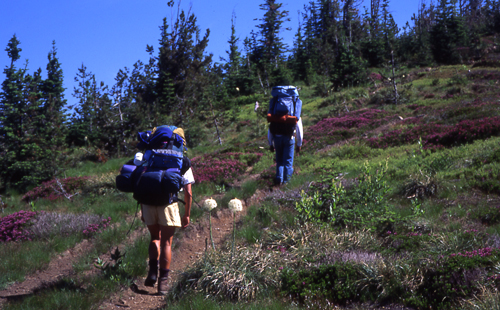Idaho State Parks provide hiking opportunities for all ages.
Hiking in Idaho State Parks

Links and downloads
- View an interactive topographical map
- View a downloadable trail overview map that includes contact information for US Forest Service and BLM offices along the way
- Download .zip file with GPS coordinates
- Download a .pdf with detailed information about the trail (signage, wildlife, access issues, re-supply points, history and more)
- Idaho Centennail Trail blog with lots of information including updates from current ICT hikers
- Idaho Public Television's informative Centennial Trail site and video clip
For more information, contact Leo Hennessy, Idaho Centennial Trail Coordinator, at leo.hennessy@idpr.idaho.gov or at 208-541-2419.
Idaho Parks and Recreation Trail Map Program
Hiking in Idaho National Forests
- Boise National Forest
- Payette National Forest
- Hells Canyon National Recreation Area
- Caribou-Targhee National Forest
- Salmon-Challis National Forest
- Clearwater National Forest
- Nez Perce National Forest
- Panhandle National Forests
- Sawtooth National Recreation Area
- Hagerman Fossil Beds National Monument
Hiking in Wilderness Areas
- Sawtooth Wilderness
- Frank Church-River of No Return Wilderness
- Owyhee Wilderness Areas
- Selway-Bitterroot Wilderness
- Gospel Hump Wilderness
- Hells Canyon Wilderness
Another good tool to find information about Wilderness Areas in Idaho is Wilderness.net.
Non-Motorized Trail Recreation Summits
The Idaho Department of Parks and Recreation (IDPR) hosted three (3) summits to discuss issues and solutions pertaining to non-motorized trail recreation in Idaho. The discussions were held in Boise, Coeur d'Alene and Idaho Falls. Below are the meeting handouts and minutes from each location. The open discussions explored all topics pertaining to non-motorized trail recreation in Idaho and ideas for solving the non-motorized trail funding gap.
Boise - February 11, 2016
Meeting Minutes
Presentation (Boise)
Coeur d'Alene - April 21, 2016
Meeting Minutes
Presentation (Coeur d'Alene)
Idaho Falls - May 2, 2016
Boise, January 11, 2017
A meeting was held January 11, 2017 to share results of the 2016 summits and to organize a leadership team, willing to take suggestions and strategies through the next very important steps. Download the meeting materials.
Summit Attendees
A complete list of summit attendees is available for download here.
Next Steps - Use collective report and results from statewide summits to answer the following:
1) Is there a need to address non-motorized trail maintenance in Idaho?
2) Is there enough support statewide to address non-motorized trail maintenance and related funding in Idaho?
3) Who will work together to address the need?
4) What does addressing the need look like?
5) What are the necessary actions / future next steps?
Want to take a leadership role? Have questions?
If you have questions, would like to lead in next steaps, or were unable to attend a summit in your area, you can share your thoughts and ideas via email: inquiry@idpr.idaho.gov
Hiking in Idaho State Parks

Links and downloads
- View an interactive topographical map
- View a downloadable trail overview map that includes contact information for US Forest Service and BLM offices along the way
- Download .zip file with GPS coordinates
- Download a .pdf with detailed information about the trail (signage, wildlife, access issues, re-supply points, history and more)
- Idaho Centennail Trail blog with lots of information including updates from current ICT hikers
- Idaho Public Television's informative Centennial Trail site and video clip
For more information, contact Leo Hennessy, Idaho Centennial Trail Coordinator, at leo.hennessy@idpr.idaho.gov or at 208-541-2419.
Idaho Parks and Recreation Trail Map Program
Hiking in Idaho National Forests
- Boise National Forest
- Payette National Forest
- Hells Canyon National Recreation Area
- Caribou-Targhee National Forest
- Salmon-Challis National Forest
- Clearwater National Forest
- Nez Perce National Forest
- Panhandle National Forests
- Sawtooth National Recreation Area
- Hagerman Fossil Beds National Monument
Hiking in Wilderness Areas
- Sawtooth Wilderness
- Frank Church-River of No Return Wilderness
- Owyhee Wilderness Areas
- Selway-Bitterroot Wilderness
- Gospel Hump Wilderness
- Hells Canyon Wilderness
Another good tool to find information about Wilderness Areas in Idaho is Wilderness.net.
Non-Motorized Trail Recreation Summits
The Idaho Department of Parks and Recreation (IDPR) hosted three (3) summits to discuss issues and solutions pertaining to non-motorized trail recreation in Idaho. The discussions were held in Boise, Coeur d'Alene and Idaho Falls. Below are the meeting handouts and minutes from each location. The open discussions explored all topics pertaining to non-motorized trail recreation in Idaho and ideas for solving the non-motorized trail funding gap.
Boise - February 11, 2016
Meeting Minutes
Presentation (Boise)
Coeur d'Alene - April 21, 2016
Meeting Minutes
Presentation (Coeur d'Alene)
Idaho Falls - May 2, 2016
Boise, January 11, 2017
A meeting was held January 11, 2017 to share results of the 2016 summits and to organize a leadership team, willing to take suggestions and strategies through the next very important steps. Download the meeting materials.
Summit Attendees
A complete list of summit attendees is available for download here.
Next Steps - Use collective report and results from statewide summits to answer the following:
1) Is there a need to address non-motorized trail maintenance in Idaho?
2) Is there enough support statewide to address non-motorized trail maintenance and related funding in Idaho?
3) Who will work together to address the need?
4) What does addressing the need look like?
5) What are the necessary actions / future next steps?
Want to take a leadership role? Have questions?
If you have questions, would like to lead in next steaps, or were unable to attend a summit in your area, you can share your thoughts and ideas via email: inquiry@idpr.idaho.gov












